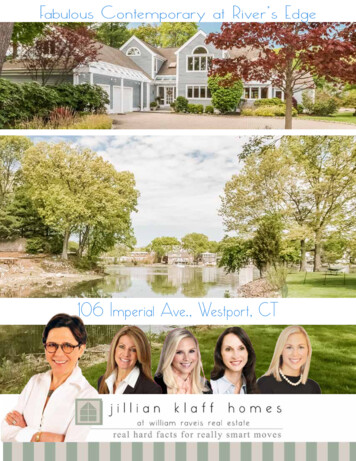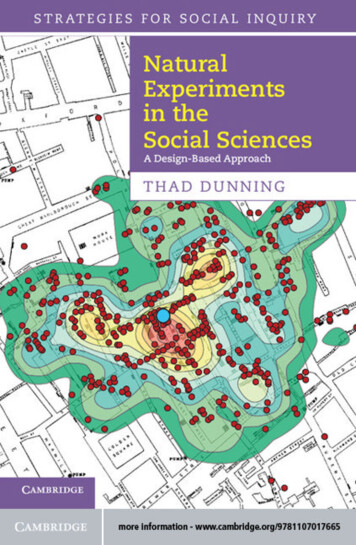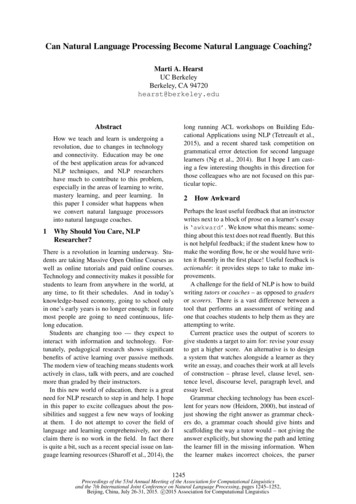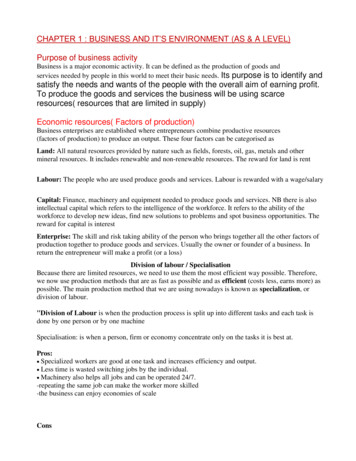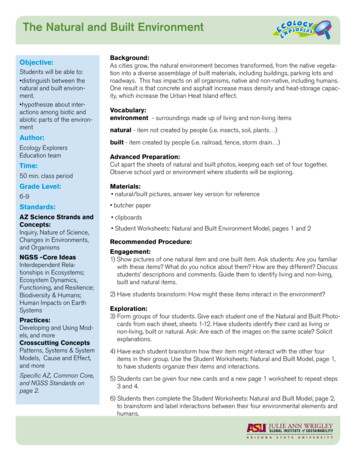
Transcription
The Natural and Built EnvironmentObjective:Students will be able to: distinguish between thenatural and built environment. hypothesize about interactions among biotic andabiotic parts of the environmentAuthor:Ecology ExplorersEducation teamTime:50 min. class periodGrade Level:Background:As cities grow, the natural environment becomes transformed, from the native vegetation into a diverse assemblage of built materials, including buildings, parking lots androadways. This has impacts on all organisms, native and non-native, including humans.One result is that concrete and asphalt increase mass density and heat-storage capacity, which increase the Urban Heat Island effect.Vocabulary:environment - surroundings made up of living and non-living itemsnatural - item not created by people (i.e. insects, soil, plants )built - item created by people (i.e. railroad, fence, storm drain )Advanced Preparation:Cut apart the sheets of natural and built photos, keeping each set of four together.Observe school yard or environment where students will be exploring.6-9Materials: natural/built pictures, answer key version for referenceStandards: butcher paperAZ Science Strands andConcepts:Inquiry, Nature of Science,Changes in Environments,and Organisms clipboardsNGSS -Core IdeasInterdependent Relationships in Ecosystems;Ecosystem Dynamics,Functioning, and Resilience;Biodiversity & Humans;Human Impacts on EarthSystemsPractices:Developing and Using Models, and moreCrosscutting ConceptsPatterns, Systems & SystemModels, Cause and Effect,and moreSpecific AZ, Common Core,and NGSS Standards onpage 2. Student Worksheets: Natural and Built Environment Model, pages 1 and 2Recommended Procedure:Engagement:1) Show pictures of one natural item and one built item. Ask students: Are you familiarwith these items? What do you notice about them? How are they different? Discussstudents’ descriptions and comments. Guide them to identify living and non-living,built and natural items.2) Have students brainstorm: How might these items interact in the environment?Exploration:3) Form groups of four students. Give each student one of the Natural and Built Photocards from each sheet, sheets 1-12. Have students identify their card as living ornon-living, built or natural. Ask: Are each of the images on the same scale? Solicitexplanations.4) Have each student brainstorm how their item might interact with the other fouritems in their group. Use the Student Worksheets: Natural and Built Model, page 1,to have students organize their items and interactions.5) Students can be given four new cards and a new page 1 worksheet to repeat steps3 and 4.6) Students then complete the Student Worksheets: Natural and Built Model, page 2,to brainstorm and label interactions between their four environmental elements andhumans.
7) Using large sheets of paper, have students arrangetheir four cards on the paper and a ‘Humans’ card torepresent how the items might interact with each other.After trying a few different configurations, ask themto decide on a permanent arrangement and tape theirphotos to the paper.Explanation:8) Guide students to use arrows or other symbols to represent the interactions. Ask them to label each arrow orsymbol with a description of the interaction.9) Ask students: Are the interactions desirable, undesirable or neutral from the perspective of each of the fouritems? Guide them to include symbols representingthese relationships next to their interaction symbols.Elaboration:10) Have each group of four pair up with another groupand compare their images and models.11) Have each student swap their image with someonefrom the other group. Each group should then return totheir own model and try to incorporate the new items,including interaction symbols.12) Additional images can be incorporated as time allows.13) Have each member of each group present one or twointeractions in their model. Ask students to summarizethe patterns they noticed and the main differences ininteractions between built and natural items. Ask: Howdo natural and built items respond differently to heat?Why?Evaluation:14) Students follow the journal prompts on Student Worksheet 3: Built and Natural Journal Writing.Extensions:15) Introduce the photos from sheets 13 and 14 to thegroups to discuss.StandardsArizona Science S1-C1-GRHS-PO1S1-C2-GR5-HS-PO1, PO5S1-C3-GR5-PO5S1-C3-GR5-PO5S1-C3-GR6-PO2Central Arizona-Phoenix Long-Term Ecological Research ProjectS1-C3-GR7-PO1, PO2, PO7S1-C3-GR8-PO1, PO2, -GR5-PO1S3-C1-GR7-PO1S3-C1-GR8-PO1, S4-C4-GR8-PO1S4-C4-GRHS-PO3,PO4
Arizona Science Standards cont’dS4-C4-GR8-PO1S4-C4-GRHS-PO3, PO4NGSS Core Ideas:ESS2.A: Earth materials and systemsESS2.E: BiogeologyESS3.C: Human impacts on Earth systemsLS2.A: Interdependent relationships in ecosystemsLS2.C: Ecosystem dynamics, functioning, and resilienceLS4.D: Biodiversity & HumansLS2.B: Cycle of Matter and Energy Transfer inEcosystemsNGSS Practices:Developing and using modelsPlanning and carrying cut investigationsConstructing explanationsObtaining, evaluating, and communicating informationNGSS Crosscutting Concepts:PatternsCause and effectScale, proportion and quantitySystems and system modelsEnergy and matter: Flows, cycles, and conservationStability and changeCommon Core/ELA LiteracyRST7: Integrate content from diverse formatsWHTS1: Write to support claimsWTS2: Write to convey ideas and informationSL1: Participate in collaborations and conversationsSL2: Integrate oral informationSL4: Present effectively to listenersCommon Core/MathematicsDomains:Number and QuantityMeasurement and DataCentral Arizona-Phoenix Long-Term Ecological Research Project
Student Worksheet 1Natural and Built Environment ModelLearning ObjectiveDistinguish between the natural and built environment in photos.Group Instructions1) Your teacher will give you each a different picture. Identify the items of interest.2) Write each group member’s item on the diagram and circle whether it is living or non-living and built or natural.3) Brainstorm with your group members how each of their items might interact with each other.4) Label each interaction by writing a short description or explanation on the arrows.living or non-livingnatural or builtliving or non-livingnatural or builtgroup member # 1group member # 2living or non-livingnatural or builtliving or non-livingnatural or builtgroup member # 3group member # 4Central Arizona-Phoenix Long-Term Ecological Research Project
Student Worksheet 2Natural and Built Environment ModelGroup Instructions1) Label the four objects in the outer circles of the model below.2) Brainstorm with your group members how each of their items might interact with yours.3) Label on the arrows to describe the interactions between each object and humans.living or non-livingnatural or builtliving or non-livingnatural or builtyour itemgroup member # 1Humansliving or non-livingnatural or builtliving or non-livingnatural or builtgroup member # 2group member # 3Central Arizona-Phoenix Long-Term Ecological Research Project
Student Worksheet 3Natural and Built Journal WritingImagine and Explain:Visualize an outdoor area near where you live, such as a front yard or park. Think about the natural and built items and howthese items interact with humans and other living organisms. Then imagine something is eliminated from this environment.Describe the environment, the missing item, and possible consequences:Central Arizona-Phoenix Long-Term Ecological Research Project
Role: shelter forpeople and otheranimalsPossible Interaction:contributes to heatisland, decreasedspace for animalsand plantsRole: eats other birds and mammalsPossible Interactions: nest on buildings or trees,reduce populations of prey animalsRole: stabilizes soil,converts suns energyto sugar, createsoxygen, uses CO2Possible Interaction:food and shelter forwildlife, aesthetics,food, and shade forpeopleRole: hard surface for vehicles, connects communities, allowsmovements of goodsPossible Interaction: can provide food for animals (road kill), decreasesspace for plants and animals, limits travel for animals, could helpspread non-native plants & animals (by vehicles or along medians),indirectly air pollution causing health issues for plants and animals
Role: eats rodentsRole: shelter for people and possibly other animalsPossible Interaction: food for other animals, beneficial to peoplefor rodent controlPossible Interaction: keeps out animals, decreased space foranimals and plants, could provide shade for animals or plantsRole: stabilizes soil,converts sunsenergy to sugar,produces oxygen,uses CO2PossibleInteraction: foodand shelter forwildlife, aesthetics,and shade forpeopleRole: place to deposit mail, communicationPossible Interaction: if abandoned could become home for animals,resting spot (birds)
Role: eats vegetation,garbage, rodents,lizards, and other smallanimalsPossible Interaction: mayhelp people bycontrolling , might alsoprey on domesticanimals (chickens,lambs, small pets), ,aesthetics, symbol of theWest (howling at night)Role: transport water from one place to another,decrease floodingPossible Interaction: food, and shelter for animals,cooling, water for plants and animalsRole: stabilizes soil,converts sunsenergy to sugar,creates oxygen,uses CO2PossibleInteraction: foodand shelter forwildlife, aestheticsfor people, spinesdeterrent for someanimalsRole: allows travel for people and goodsPossible Interaction: can indirectly relate to food for animals (trainkill), abandoned railroad beds have been converted to recreationaluse, can transport seeds and animals along routes
Role: eats insects, tadpoles, fish, and grainsPossible Interaction: food for other animals (raptors), can damagecrops, population increases with human altered landscapeRole: stabilizes soil,converts suns energyto sugar, producesoxygen, uses CO2Possible Interaction:food for animals,shelter for smallanimals, aestheticsand place to play forpeople, cooling effectRole: shelter for people and possibly other animalsPossible Interaction: keeps out animals, decreased space foranimals and plants, could provide shade for animals or plantsRole: emergencywater supply for fires,Possible Interaction:perching spot foranimals, marking spotfor dogs,
Role: aesthetics forpeople, gathering placePossible Interaction:cooling effect, water forbirds and other animalsto drinkRole: consumes insects and aquatic vegetationPossible Interaction: food for other animals, hunted by people, aesthetics forpeopleRole: stabilizes soil,converts sunsenergy to sugar,produces oxygen,uses CO2PossibleInteraction: foodand shelter forwildlife, aesthetics,and food forpeople, shadecools buildingsRole: place to walk, separates pedestrians from road andprivate propertyPossible Interaction: can indirectly relate to food for animals(people drop food while walking), decreases space for plantsand animals (weeds might grow in cracks), could increaserunoff.
Role: consumesarthropodsPossibleInteraction: eatenby other animals,keeps some animalpopulations downthrough predation,burrowing specieshelp aerate the soil,poisonous topeopleRole: recreation for people, green space,gathering placePossible Interaction: home for small animals,potential food from vegetation and garbageRole: hold solid waste,keeps area clean soless chance ofdiseasePossible interaction:could provide food foranimals if not properlyclosedRole: stabilizes soil, converts suns energy to sugar,produces flowers and seeds to reproducePossible Interaction: food for animals, aesthetics
Role: decreasesrunoff so lessflooding on roadsPossibleInteraction: locationof food, and shelterfor animals, waterfor plants andanimalsRole: eats insects (adult), eats algae (tadpole)Possible Interaction: food for other animals. Night-time noises,beneficial to people for insect controlRole: stabilizes soil,converts sun’senergy to sugar,produces oxygen,uses CO2Possible Interaction:food and shelter foranimals, aestheticsfor people, cooling,nesting site for birdsRole: controls traffic,Possible Interaction:perching site forbirds, safety
Role: Consumes otherarthropodsPossible Interaction: mayhelp people by controllingother arthropodpopulations, food for otheranimals such as birdsRole: hard surface for vehicles to park, access for shopping, hardsurface for recreation (festivals, flea markers )Possible Interaction: can provide food for animals (dropped food),decreases space for plants and animals, can heat surrounding area,can increase runoff, runoff can have pollutants (oil from cars)Role: stabilizes soil,converts suns energyto sugar, producesoxygen, uses CO2Possible Interaction:food and shelter forwildlife, nurse plant forother plants (provideshelter from sun)Role: allows travel from one place to anotherPossible Interaction: makes faster travelpossible for people, can indirectly relate to foodfor animals (food dropped), decreases space forplants and animals, aesthetics for people
Role: eats plants (larval stage), pollinates plants (adult stage)Possible Interaction: important pollinator (possibly for crops), food foranimals, aesthetics for people, pest to plants –may cause people to useinsecticidesRole: stabilizes soil,converts suns energy tosugar, produces flowersand seeds.Possible Interaction: foodand shelter for animals,aesthetics for people,may shade buildingsRole: dissuade movement, defines boundariesPossible Interaction: perching site for birds, could be barrier tomigration route to animals, can be decorative or historicRole: recreationfor peoplePossibleInteraction:perching site forbirds, if netunravels couldbecome part ofa nest or placefor nesting
Role: eats decaying organic materialRole: place for people to exercise relax and stay coolPossible Interaction: food for other animals , people may not like themand may spray pesticidesPossible Interaction: cooling effect for animals in local area, water forbirds and other animals to drink, wastes waterRole: stabilizes soil,converts sunsenergy to sugar,produces oxygen,uses CO2PossibleInteraction: foodand shelter forwildlife, nurse plantfor other plants(provide shelterfrom sun),aestheticsRole: measuresenergy for peoplePossible Interaction:perching site for birds,electricity helps runelectronics that can bebeneficial such askeeping people cool,indirectly contributesto pollution that canaffect animals andplants (air)
Role: consumes variety of wild seeds, grains, and insectsPossible Interaction: food for other animals, control insect populations,nests and droppings near people, aesthetics for people, attracted to waterRole: electric wires provides energy and lights illuminatestreetPossible Interaction: perching site for birds, possible nestingplace, improve street appearance & safety contributes topollution that can affect animals and plants (light, air)Role: stabilizes soil, converts suns energy to sugar, produces flowersand seeds to reproduce, uses water, takes up CO2 and gives off O2 andwater vapor.Role: place to gather and restPossible Interaction: food for animals, aesthetics, ground cover preventserosion and dustPossible Interaction: could provide shade /resting area for animals.Place to view nature for people
Natural and Built Environment Model Learning Objective Distinguish between the natural and built environment in photos. Group Instructions 1) Your teacher will give you each a different picture. Identify the items of interest. 2) Write each group member’s item on the diagram and circle whether it is living


